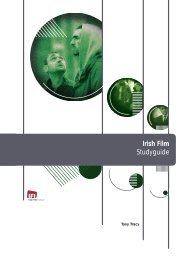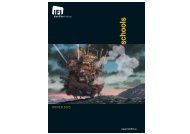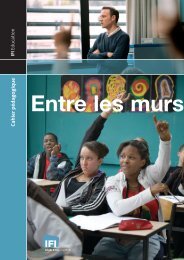Madagascar - Irish Film Institute
Madagascar - Irish Film Institute
Madagascar - Irish Film Institute
Create successful ePaper yourself
Turn your PDF publications into a flip-book with our unique Google optimized e-Paper software.
The <strong>Irish</strong> <strong>Film</strong> <strong>Institute</strong> & Royal <strong>Irish</strong> Academy presentIFI Education© DreamWorks AnimationFollow-up Classroom Activities for Hamilton Year of Science 2005© DreamWorks Animation
Introduction& SynopsisIntroductionThe Royal <strong>Irish</strong> Academy, Ireland’s academy for the sciences, humanities and social sciences,co-ordinated events in 2005 celebrating the life of Ireland’s most eminent scientist, WilliamRowan Hamilton (1805 – 65). He is best known for his discovery in 1843 of quaternions – animportant mathematical expression used in describing 3D spaces in computer graphics –whilst walking along the Royal Canal in Dublin.In association with the Royal <strong>Irish</strong> Academy, and as an extension of Hamilton Year of Science2005, IFI Education is delighted to present this study guide, based on popular animatedfeature <strong>Madagascar</strong>.The study guide contains follow-up classroom activities with a primary science focus.Section One – Teacher GuidelinesSection Two – Student Activity Sheets 1 – 7I hope you will find this study guide a useful, interesting and fun resource in your teachingof science in the primary curriculum.Ann RyanEducation Officer<strong>Irish</strong> <strong>Film</strong> <strong>Institute</strong>SynopsisAlex the Lion (voiced by Ben Stiller), Marty the Zebra (Chris Rock), Melman the Giraffe (DavidSchwimmer) and Gloria the Hippo (Jada Pinkett Smith) live happily at New York Zoo. Butwhen Marty discovers that a group of plotting penguins are planning an escape to ‘the wild’he decides to do the same – even though he has no idea what to expect. Eventually, aftersome hilarious misadventures, all four end up on the island of <strong>Madagascar</strong>.Alex, the most reluctant escapee, is desperate to get back to the zoo, but finds that hisnatural hunting instincts are beginning to surface – and he begins to view his best friendMarty as a tasty dinner! The chase is on to get back to New York and the safety and comfortof the zoo.USA • 2004 • Animation • 80 mins • <strong>Film</strong> Classification: GDirectors: Eric Darnell/Tom McGrath
ContentsLesson Title Section 1 –TeacherGuidelinesSection 2 –ActivitySheets1. What do we like to eat? Page 1 Page 92. Do you have a NOSE for food? Page 2 Page 10 & 113. Animal tastes Page 2 & 3 Page 124. Species & habitats Page 3 & 4 Page 135. Animal families & facts Page 4 Page 14 & 156. Camouflage Page 5 Page 167. Escape from <strong>Madagascar</strong> Page 6 Page 17Answers to 4 & 5 Page 7 & 8 –
Section OneTeacher Guidelines© DreamWorks AnimationSection One – Teacher GuidelinesLesson 1 – What do we like to eat?1. Refer to the animal characters from <strong>Madagascar</strong> and discuss what theyeach like to eat – eg Alex likes eating steaks. Make the point that Alex,Marty, Gloria and Melman live in captivity at the zoo so they don’t haveto hunt/look for food as they would have to do in the wild.Discussion questions to include:• Did the zookeepers look after the animals well?• What kinds of food did they feed them?• Do you think the animals would have been able to find their ownfood if they were set free?• We all have different tastes too! What do you like to eat? How aboutyour classmates?Learningobjectives inLesson 1:Record andrecognise differenteating habits/dietsMethodologies:Researching,Communicating,Prediction andrecordingPair/Group work2. Pupils to use dictionaries to find definitions of the following words:captivity, diet, habitat3. Refer to Activity Sheet 1. Divide class into groups. Ask them to recordwhat each member usually eats for different mealtimes, e.g. breakfast,lunch, dinner, snacks.4. Ask students to compare their findings with other groups.Discussion questions could include:• Are there any similarities/differences?• Do we all like the same foods?• Does anyone have a special diet? (e.g. vegetarian)5. Ask students to display their results graphically, e.g. in a bar chart or apie chart.6. Further discussion:• Is there a difference between the foods we like to eat, and the foodswe need to eat to stay healthy?• Are there some ‘junk’ foods listed among our favourites?• What have we learned about our eating habits from this activity?01
Section One – Teacher GuidelinesLesson 2 – Do you have a NOSE for food?1. Refer to Activity Sheet 2.a. Students to work in pairs to recognise different kinds of foodusing their senses of taste, touch and smell.• Prepare a selection of food of different sorts: fruit segments,vegetable slices and grain based products, such as breakfastcereals, bread, crackers or biscuits. You will also needscarves/material to use as blindfolds.• Sort food into Set A and Set B with a selection in each set.• Students work in pairs with one of them blind-folded. Theother student gives him/her a piece of food from Set A, andthe blindfolded student has to guess what the food is, usinghis/her senses of smell, touch and taste.• Then, guessing again, student is asked to touch and taste thefood but hold his/her nose to avoid smelling it.• When all the foods from Set A have been sampled, askstudents to swap blindfolds, and follow the same guessingsteps as before, this time with foods from Set B.Learning objectivesin Lesson 2:Explore differentfoods using senseof smell, touch andtaste.Methodologies:Prediction,recording andassessing resultsPair/Group work2. Follow-up discussion of the results to include the followingquestions:• What were your guesses like when you could touch, taste andsmell the food?• What were your guesses like when you could touch and taste thefood but not smell it?• What did you learn about your sense of smell from this activity?Lesson 3 – Animal tastes1. Introduce the concept of classifying animals according to their diets.Possible questions:• What foods do lions eat?• What do rabbits eat?• What is the difference in their diets?• How do we describe/define this?Learning objectivesin Lesson 3:Classify andcompare animalsaccording to dietMethodologies:Researching andcommunicatingIndividual/pair/group work 02
Section One – Teacher GuidelinesLesson 3 – Animal tastes (cont)2. Ask pupils to complete Activity Sheet 3.a. Classifying• Use a dictionary to find out the meanings of the words on the left.• Match with the words on the right.b. Who is the odd one out?• Match the <strong>Madagascar</strong> characters with their species, then withtheir diets. Who is the odd one out? Why?• Which of the four friends is nocturnal? (Answer: Gloria the hippo)Lesson 4 – Species & habitats1. Think about where we live. How can we describe our habitat?a. Is it urban or rural?b. What sort of climate do we have?c. Describe your location. What does it look like?2. Our HabitatIn groups, make a poster to display the information you find out aboutyour habitat. Use different headings and pictures as well as words.Compare with other groups.3. In the film, Alex, Marty, Gloria and Melman are friends even though theyare from different species.Learning objectivesin Lesson 4:Recognise differentanimal species andhabitats. Recognisedifferent aspects ofwhere they liveMethodologies:Researching usingthe InternetGroup, pair,individual workDiscuss:• Do you think they would have known each other if they really did livein ‘The Wild’ as Marty suggested?• What kind of habitat would they live in?03
Section One – Teacher GuidelinesLesson 4 – Species & habitats (cont)4. Pupils to do the following:a. Find out where these animals live in real life and what they eat there.b. As you research, fill your answers into the grid on Activity Sheet 4.There are extra spaces so you can choose some more species to research.Check answers at the end of Section One – Teacher Guidelines.Useful websites for this activity include:Fota Wildlife Park, Cork: www.fotawildlife.ieDublin Zoo: www.dublinzoo.ie<strong>Madagascar</strong> Movie: www.madagascar-themovie.com/PBS: www.pbs.org/edens/madagascarWorld Wildlife: www.worldwildlife.org/wildplaces/mad/index.cfmLesson 5 – Animal families and factsI) Animal Families1. Collective nounsIntroduce the idea of collective nouns to describe groups of animals.a. Do you know the names for groups of some of the animals in the film?e.g. a group of lions is called ‘a pride of lions.’b. Pupils to match the collective nouns to the correct animals on ActivitySheet 5, the answers to which are at the bottom of the page.II) Animal FactsLearning objectivesin Lesson 5:Find collectivenouns for animalfamiliesMethodologies:Investigation &research usingdictionariesIndividual/pairwork1. True or False?Introduce the idea of facts about animals, referring to the statements onActivity Sheet 5.Some statements are true and some are false. E.g. first statement – Do polarbears eat penguins? Ask class for a show of hands for True, and a show ofhands for False. Then tell them the correct answer (False. Polar bears do notlive in the Antarctic, where penguins live, so they never meet!) Checkanswers at the end of Section One – Teacher Guidelines.04
Section One – Teacher GuidelinesLesson 6 – Camouflage1. Pupils to use dictionaries to find definitions of:camouflage, predator2. Children can discover how camouflage works by creating abackground in which an animal can ‘hide’. (Activity Sheet 6)Materials:paper, scissors, collection of science/nature magazines, a selectionof textures cut from magazine illustrations, glue, coloured markers.Instructions to pupils:1) Look through some magazines to find an interesting picture ofan animal or other creature.2) Cut out the animal carefully making sure you cut away all ofthe background.3) Looking at the colours of the animal prepare a differentbackground for it in which it can ‘hide’ from predators.4) Use coloured paper or paint a background that you think willwork.5) Making sure the new background is dry, glue on the animal.6) Next add some details such as trees, leaves or stick on texturesto ensure that your creature is well camouflaged.7) When you have finished ask your classmates if they can seewhere and what the animal is. If you want another challenge,try to camouflage a zebra!!Learning objectivesin Lesson 6:Design and makesuitablebackground to‘hide’ orcamouflage animalMethodologies:Researching,selecting usingmagazinesIndividual/pairwork05
Section One – Teacher GuidelinesLesson 7 – Escape from <strong>Madagascar</strong>!1. Make an escape vessel. Refer to Activity Sheet 7.a. Introduce the idea of designing and making an escape vessel. Thisactivity may be carried out over a number of lessons.Discuss:• What materials will float?• How can you hold them together?• Which size would float best?NB: Children will need a variety of materials from which to make theirvessel: plastic tubs, card, cartons, food trays, wooden dowels or lollipopsticks, glue, lego, small pieces of light wood, plasticine, etc. Encouragechildren to come up with a range of solutions – they need not allproduce the same vessel.Learning objectivesin Lesson 7:Identify materialsthat float.Designing andmaking an escapevessel.Methodologies:Brainstorming andresearch, designingand making.Group/pair workInstructions to pupils:Design: Once you have chosen a suitable material start designing yourraft or boat. Draw some ideas first.Make: Put together your raft or boat. Remember to allow lots of timefor the glue to dry before trying to launch the craft!Test: Try launching your raft/boat in the sink or in a basin of water. Itwill need to take at least one passenger (model-sized) and withstandsome choppy seas (ask your classmates to help you!).Review: How did it go? After testing your raft/boat, make any changesthat you think are needed to improve it. Then, check out some of theother designs in the class. Are there some that float more easily thanothers? Why?06
Section One – Teacher GuidelinesAnswers to Lesson 4 – Species & habitatsQuestion 4bSpecies Habitat Location DietLion Grasslands and the South of the Sahara Antelope, zebras,savannah in Africa warthogs,giraffes, buffaloZebra Grasslands and the South of the Sahara Short grass andsavannah in Africa leavesHippopotamus Deep water, rivers or South of the Sahara Nile River valleylakes with reed beds or in Africa in East Africagrasslands nearbyGRASS – up to 45kgin one nightGiraffe Grasslands and the South of the Sahara Accacia andsavannah where there in Africa Mimosa trees –are treesup to 35kg a dayPenguin Climates ranging from Southern hemisphere – Fish and squidwarm tropics to the cold Australia, New Zealand,regions. Predator-free Africa and Antarcticaislands or remote partsof continentsChimpanzee Tropical rain forests, Western and Central Leaves, fruit, seeds,woodlands and Africa tree bark, flowers,grasslandsant, termitesand small animalsFossa Tropical rain forest and <strong>Madagascar</strong> Small birds andbush forestmammals, reptilesand frogs.Lemur Tropical rain forest and <strong>Madagascar</strong> Plants, leaves,scrub forestflowers, fruits andsometimes insects07
Section One – Teacher GuidelinesLesson 5 Answers – Animal families and factsI) Animal families – Question 1b.1b. Collective nouns1) pride, 2) herd, 3) tower, 4) herd, 5) huddle, 6) gaggle, 7) school, 8) colony, 9) caravan,10) litterII) Animal facts – Question 1a.1a. True or False?1) False Unlike penguins, polar bears do not live in the Antarctic.2) True This is the same number of bones that you have in your neck (humans)3) False The hippo is native to East Africa.4) False No two zebras are identical - each one has a unique pattern.5) True Male sea-horses do give birth to their young6) False A cheetah is the fastest, reaching speeds up to 76kph. The fastest humanscan only reach 30kph.7) False It uses its tongue!8) True A jellyfish is 95% water!9) False In 1957 the Russians launched Sputnik 2, with a dog called Laika on board.10) False A mouse next to an elephant is so small that the elephant would not evenknow that there is a mouse close to it!08
Section TwoActivity Sheets© DreamWorks AnimationSection Two – Activity Sheet 1Lesson 1 – What do we like to eat?In groups, complete the table below as you find out what you andyour friends like to eat at different times of the day. Then, compareyour results with other groups in the class. You can also display theresults in a graph.Name Breakfast Lunch Dinner SnacksWhat have you learned about your eating habits from this activity?09
Section Two – Activity Sheet 2Lesson 2 – Do you have a NOSE for food?Work with a partner for this activity. You will be finding out ifyou can recognise different kinds of food using your sense oftouch, taste, and especially smell. One of you needs to wear ablindfold. Your teacher will provide you with a set of food samples.a) Guess the food, using your sense of smell, touch and taste.b) Guess the food, this time holding your nose while you touch and taste.Your partner will write down the guesses. When you have finished your set,take off the blindfold and check your answers.NameFood a) Smell it and b) Hold your Tick if you Tick if youSet A guess the food! nose, then guess! were right were rightfor a) for b)1234510
Section Two – Activity Sheet 2NameFood a) Smell it and b) Hold your Tick if you Tick if youSet B guess the food! nose, then guess! were right were rightfor a) for b)12345Lesson 2 – Do you have a NOSE for food? (cont.)a. What were your guesses like when you could touch and taste thefood but not smell it?b. What were your guesses like when you could touch, taste and smellthe food?c. What did you learn about your sense of smell from this activity?11
Section Two – Activity Sheet 3Lesson 3 – Animal tastesClassifyinga. Use the dictionary to find out the meanings of the words on the left.b. Match with the words on the right.CarnivoreHerbivoreOmnivorean animal that feeds on plantsan animal that feeds on fleshan animal that feeds on avariety of foodWho is the odd one out?a. Match the animals from the film with their species, then withtheir diet. Who is the odd one out? Why?© DreamWorks Animation© DreamWorks AnimationAlex Marty Melman Gloria© DreamWorks Animation© DreamWorks AnimationHerbivoreCarnivoreLionHippopotamusZebraGiraffeb. There is another reason one of the friends may be the odd oneout. Find out which one of the animals is nocturnal.12
Section Two – Activity Sheet 4Lesson 4 – Species and habitatsIn the film, Alex, Marty, Gloria and Melman were friends even thoughthey are from different species. What kind of habitat would theseanimals usually live in?Find out where these animals live in real life and what they eat there. Asyou research, fill your answers into the grid below. There are extra spacesto allow you to choose species you would like to research yourself.Species Habitat Location DietLionZebraHippopotamusGiraffePenguinChimpanzeeFoosaLemur13
Section Two – Activity Sheet 5Lesson 5 – Animal families and factsA group of birds is called a flock of birds. Words that describe a group orfamily of animals are called collective nouns. Look at the list of animalsbelow. Match the animals with their collective nouns on the right. Thencheck your answers below.1) A of lions.2) A of zebras.3) A of giraffes.4) A of hippos.5) A of penguins.6) A of geese.7) A of whales.8) A of ants.9) A of camels.10)A of pups.pride, tower, huddle, herd, gaggle, school, litter, herd,colony, caravanAnswers to Animal Families: 1) pride 2) herd 3) tower 4) herd 5) huddle) 6) gaggle) 7) school 8) colony 9) caravan 10) litter14
Section Two – Activity Sheet 5Lesson 5 – Animal families and facts (cont)Read the sentences below about different animals. Are they True or False?What do you think? Circle T or F for each of the sentences and then checkyour answers with your teacher.True False1) Polar bears eat penguins. T F2) There are seven bones in a giraffe’s neck. T F3) The hippo is native to South America. T F4) All zebras have the same pattern. T F5) A male seahorse gives birth to its young. T F6) A leopard is the fastest land mammal. T F7) Giraffes use leaves on trees to clean its ears. T F8) A jellyfish is mostly made up of water. T F9) The first animal in space was a chimpanzee. T F10) Elephants are afraid of mice. T F15
Section Two – Activity Sheet 6Lesson 6 – CamouflageThis involves disguising something in order to hide it.A zebra, like Marty in <strong>Madagascar</strong>, has markings thatrun off its edges into the background. This allows thezebra to fade into the background so it is difficult tosee it.You can find out how camouflage works by creating a background in which ananimal can ‘hide.’You will need:paper, scissors, science/nature magazines, glue, colouredmarkers.Instructions to pupils:1) Find an interesting picture of an animal.2) Cut out the animal, making sure you cut away all of thebackground.3) Look at the colours of the animal and then startmaking a different background for it so it can ‘hide.4) Use coloured paper or paint a background that youthink will work.5) Glue the animal to your background.6) Add some other things to the background, like treesand leaves.7) When you have finished, ask your classmates to findthe animal in the picture. How well have you hidden it?If you want another challenge, try to camouflage a zebra!16
Section Two – Activity Sheet 7Lesson 7 – Escape from <strong>Madagascar</strong>!Work in groups to design and make a raft or boat to escape from the island.Design: Once you have chosen a suitable material, start designing your raftor boat. Draw some ideas first before making a final design choice.Make: Put together your raft or boat. Remember to allow lots of time for theglue to dry before trying to launch it.Test: Try launching your raft/boat in the sink or in a basin of water. It willneed to take at least one passenger (model-sized!) and should float inchoppy waters. (Ask your classmates to help you).Review: How did it go? After testing your raft/boat, make any changes thatyou think are needed to improve it.Check out some of the other designs in the class. Are there some that floatmore easily than others? Why?17
Curriculum &AcknowledgementsCurriculumThese activities support the Revised Primary School Science curriculum addressing thefollowing content objectives:Strand: Living Things (Primary School Science Curriculum p 84)Strand unit: Plant and Animal LifeVariety and characteristics of living things.• Develop an increasing awareness of plants and animals from wider environments• Identify the interrelationships and interdependence between plants and animals inlocal and other habitats• Observe and explore some ways in which plant and animal behaviour is influenced by,or adapted to, environmental conditions• Recognise that there is a great diversity of plants and animals in different regions andenvironments• Group and compare living things into sets according to their similarities anddifferences• Become familiar with the characteristics of some major groups of living thingsStrand: Energy and Forces (Primary School Science Curriculum p 65 & 87)Strand unit: Forces• identify and explore how objects and materials may be movedAcknowledgementsWritten by: Fíona LynchEdited by: Alicia McGivern & Ann Ryan, IFI EducationImages from <strong>Madagascar</strong> courtesy of Dreamworks Animation.www.ria.ie
© <strong>Irish</strong> <strong>Film</strong> <strong>Institute</strong> 2005. <strong>Irish</strong> <strong>Film</strong> <strong>Institute</strong>, 6 Eustace Street, Dublin 2.T: 01 679 5744 E: education@irishfilm.ie W: www.irishfilm.ie

















